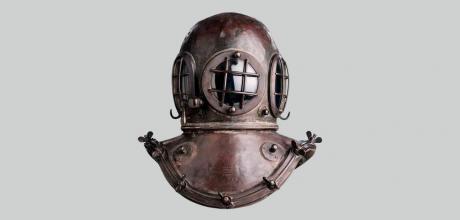Diving helmet

Familiar from generations of Hollywood movies, the diving bonnet was actually created in central London
© THE BOARD OF TRUSTEES OF THE SCIENCE MUSEUM
There’s no historical record of deep water diving activity around Denmark Street in London’s Soho. In the 20th Century it became known as Britain’s ‘Tin Pan Alley’, and a blue plaque commemorates the fact, but more observant passers-by will notice high on the face of no.5 another plaque, to ‘Augustus Siebe, 1788-1872, Pioneer of the Diving Helmet.’
Before Siebe, history is littered with attempts to make a practical diving suit. Almost inevitably, Leonardo da Vinci – who seems to have anticipated just about every modern mechanical invention – in 1500 proposed one made of leather with an attached hood containing air. Even Siebe’s diving helmet was a modification of a job commissioned by the Deane brothers in 1823, the year that Charles Deane was granted a patent for a device with the snappy title, ‘Apparatus or Machines to be worn by Persons entering Rooms or other places filled with Smoke or other Vapour, for the purpose of extinguishing Fire, or extricating Persons or Property therein’.
It’s reported that the idea came to younger brother John in a moment of improvisation. He was passing a farm(some say an inn) where a fire had trapped horses in a stable. Rushing to help, he spotted an ancient suit of armour in the farm/inn entrance, grabbed the helmet, stuffed the hose from a nearby water pump – apparently pumping more air than water – into the helmet and strode into the smoke to rescue the horses. Confident they had hit on a moneymaking idea, the brothers made a copper helmet with porthole windows that extended over the chest and shoulders, where it was riveted to a leather jerkin. Two hoses were fixed to the helmet; one allowed air to be pumped in from a hand-operated bellows and the other let spent air out. The Deanes touted their invention around fire insurance companies and the Admiralty but no-one was interested.
Marine salvage was a lucrative but tricky business and the brothers, both ex-sailors, realised that the suit could be adapted for use underwater. So they commissioned German émigré Augustus Siebe – who served as a gunnery lieutenant at Waterloo before moving to England – to manufacture a revised version.
The new suit was ready in 1828 and featured a more substantial diving ‘bonnet’, as they are rather quaintly known, attached to a sleeveless jerkin worn over a full-length waterproof ‘onesie’ entered through the neck. The exit hose was eliminated, and exhaled air simply bubbled out from under the helmet’s jacket. It was in principle a miniaturised diving bell with the drawback that the diver had to remain more-or-less vertical while submerged. Too much tilt and air would rush out and water would rush in. Despite its limitations, the Deanes’ suit was a significant advance in underwater work and they were soon in demand as divers and suppliers of suits.
Siebe had ideas of his own for further improvements and, applying suggestions from another engineer and diver, George Edwards, extended the metal corselet (the bit that supports the helmet on the shoulders) and bolted it directly to the waterproof suit, courtesy of Mr Macintosh’s recently invented rubberised cloth. An interrupted thread around the corselet’s neck allowed the bonnet to be easily removed with an eighth of a turn, but perhaps most significantly Seibe also devised a spring-loaded exhaust valve to vent air and control pressure in the suit.
The watertight Siebe suit appeared in 1837 and, with only minor modifications, formed the ‘standard diving dress’ for the ensuing 150 years or so, as well being the foundation of the famous Siebe Gorman Company.
It wasn’t long before deep-sea diving caught the public’s imagination, helped in 1869 by French author Jules Verne’s 20,000 Leagues Under the Sea, which featured, among other predictions, divers walking on the sea bed. A 1916 film of the yarn set a trend with what, for the day, must have been thrilling underwater sequences using real divers. In 1942, Cecil B DeMille’s Reap the Wild Wind was Hollywood’s fourth biggest grossing movie and famous for John Wayne’s underwater wrestling match with a giant squid. The star wore a specially constructed diving helmet with oversize face ports, so you could catch his every grimace. Perhaps the most bizarre incident involving a diving suit occurred in 1936, when Salvador Dali turned up at a Surrealist exhibition in a London gallery clad in the full gear. He was, as he put it, ‘going to dive into the depths of the human subconscious’. What depth he reached is unrecorded but he almost failed to surface as, with no water involved, there was no air being pumped into the suit and he almost suffocated before anyone noticed.
Although superseded, ‘hard hat’ gear is still used commercially in several parts of the world and the more adventurous among us can experience ‘vintage’ diving at enthusiast-run courses in the UK and abroad.

